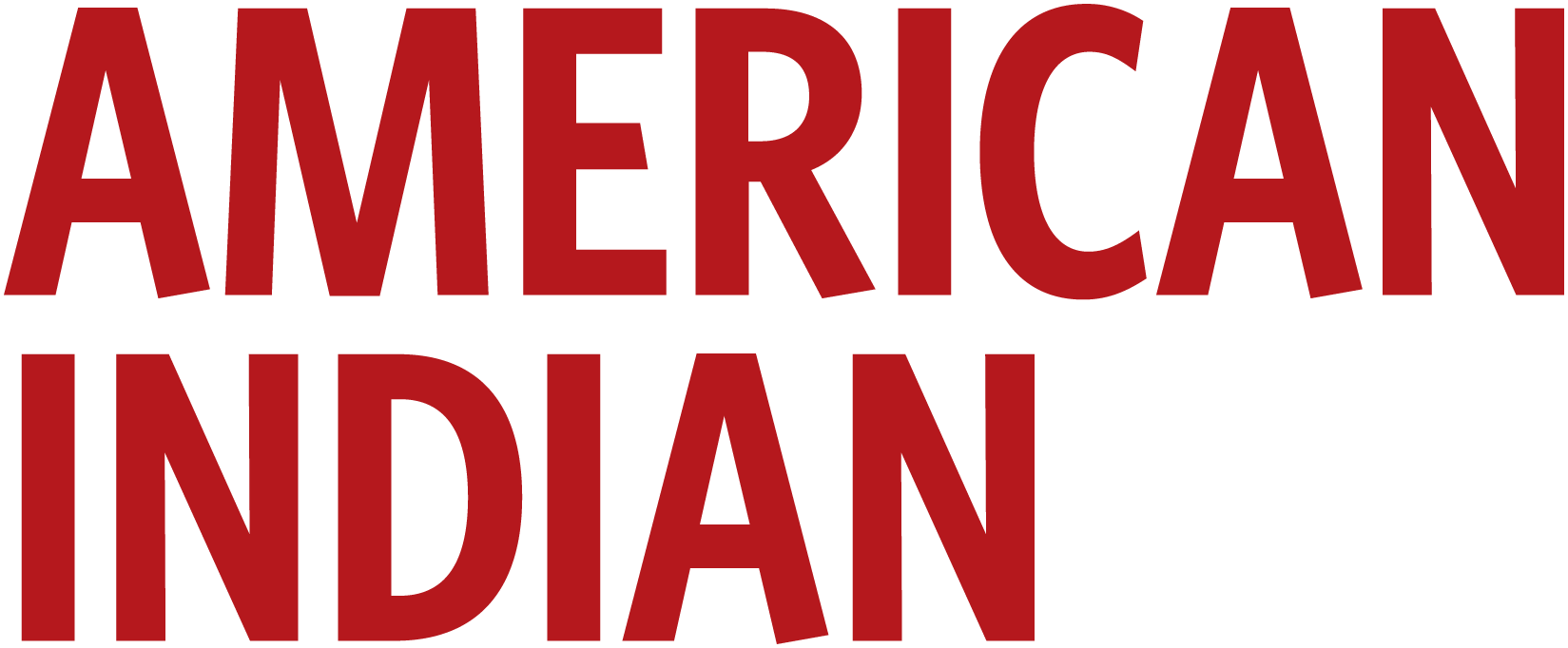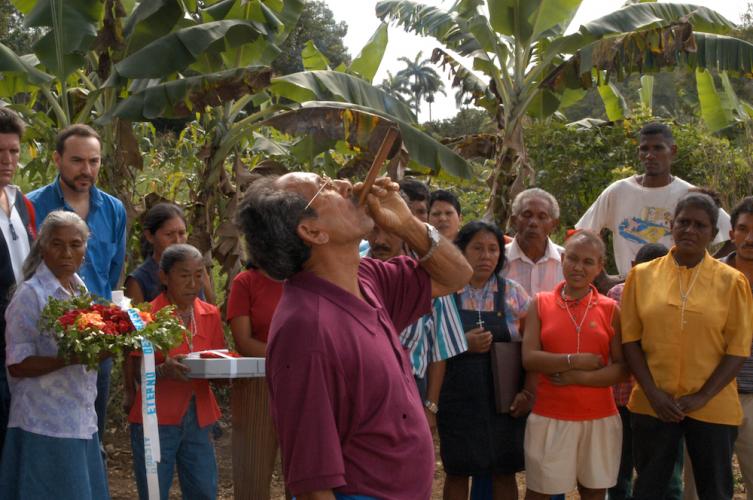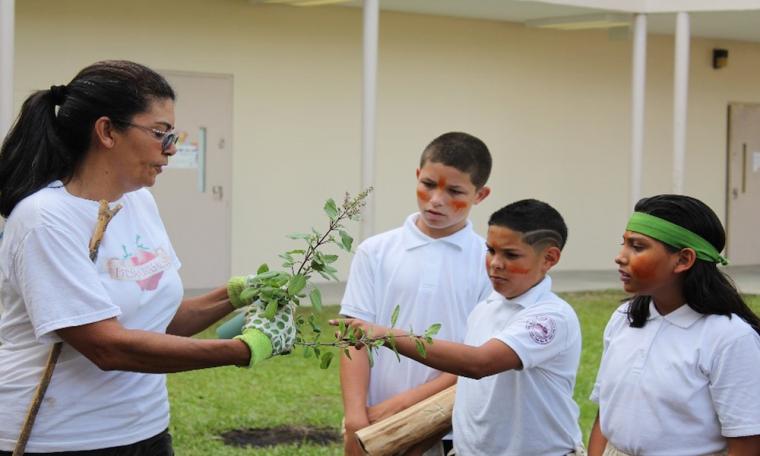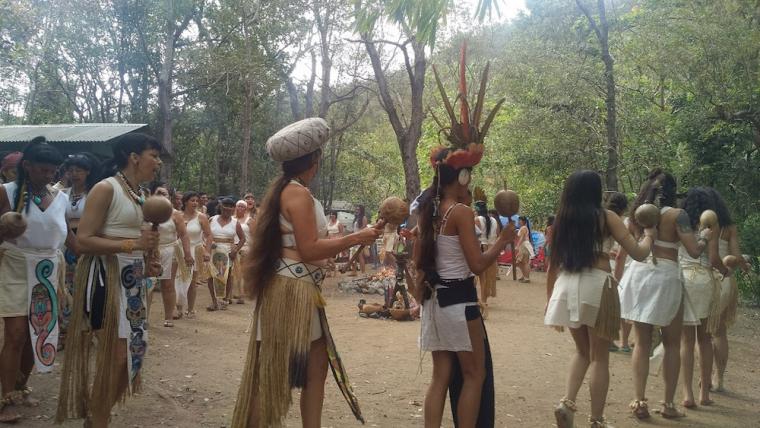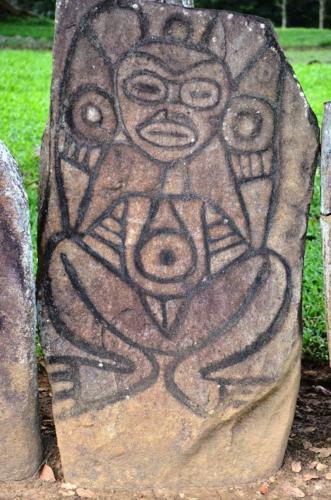“Prepárate, mi gente. Algo viene.”
(Get ready, my people. Something is coming.)
I tilted my head attentively towards the man in trance. I was with members of an Indigenous Caribbean Taíno community, all eagerly waiting to receive this message during a meeting-turned-spontaneous-channeling-session at a private Brooklyn residence in August 2017. Back in April, and again in July, of that year, channeled ancestors issued repeated warnings to them through ceremonies in Puerto Rico of an impending disaster to strike the island and surrounding region. This disaster, they warned, would be particularly devastating, denying many food and water. Community members were told to prepare for the difficulties ahead. Little did they know how imminent a threat this was and in what form it would take.
A few weeks following this prediction one of the strongest storms ever recorded in the Atlantic arrived as Hurricane Irma. Irma swept across the Caribbean, devastating isles like the Virgin Islands and Saint Martin, sending Florida into a state of emergency and leaving more than a million people in Puerto Rico’s northern coast without power, and some without homes. Less than two weeks later, Hurricane Maria unexpectedly appeared. With winds reportedly greater than 185 mph, Maria catapulted Puerto Rico into darkness, leveling its power grid and cutting off telecommunications, roads and highways, contaminating its water supply and plummeting the U.S. territory into a humanitarian crisis from which, almost a year later, its people are still recovering.
“Prepárate, mi gente. Algo viene.”
More than 500 years ago, the Indigenous Peoples of the Greater Antilles – popularly referred to today as Taíno – were greeted by a different kind of storm: European colonization. From the late-15th century, Christopher Columbus and other representatives of the Spanish Crown carried out systematic campaigns of conquest over lands, resources, bodies and souls. The Caribbean was the experimental playground for what became an expansive and competitive quest among European powers to dominate and restructure the planet according to their ambitions, worldviews and value systems. As the first victims of this perfect storm, Taíno came to be written off as the world’s paradigmatic extinct Native.
One of the many ways Taíno have survived, however, is through words like hurakan (hurricane). From an ancient Taíno perspective, the hurakan was an expression of the fury of Guabancex, mistress of violent churnings of wind and rain, and one of the manifestations of Atabey (the consciousness of Mother Earth). Guabancex is chaos incarnate; yet, her power was not seen as merely a destructive force of death, but part of a transformational cycle leading to new life and balance.
“Prepárate, mi gente. Algo viene.”
After centuries of purported extinction, the Taíno resurgence movement emerged around the time of the quincentennial celebrations of Columbus’ so-called discovery of the “New World” by people proclaiming themselves the survivors of the Caribbean’s colonial tempest. The movement developed as a collective effort mostly by diasporic Caribbeans from the islands of Puerto Rico, the Dominican Republic and Cuba, to explore and illuminate Native Caribbean survivals, and to organize around and assert Taíno identity and worldviews. Around the same time, Panchito Ramírez, hereditary cacique (chief) of Caridad de los Indios, Cuba, issued a mandate to “let the world know of our existence,” ending his community’s isolation, which, along with other unique geographic, political and historical factors had enabled them to maintain their Indigenous culture and identity throughout the post-Columbian era.
Taíno: Native Heritage and Identity in the Caribbean running at the George Gustav Heye Center of the National Museum of the American Indian – Smithsonian in New York City until October 2019, is a first-of-its-kind exhibit that contextualizes this movement and highlights the Native legacies that persist in the Hispanophone Caribbean. These range from material cultural practices like magüey hammock-weaving; toponymy and retention of Native words; foodways and staple crops like yuca; and the continued application of Native agronomical and piscatorial technologies and knowledge.
Beyond material legacies and identity assertions, Taíno resurgence revolves around living in the world in a Native Caribbean way. Many in the movement call upon embodied memories of traditions and values disseminated across generations, often by family matriarchs, which espoused mindful relations in a world where all things have life, from plants, stones, rivers, forests, caves, sun and moon, to deceased relatives and disincarnate beings inhabiting their islands. Marilyn Balana’ni Díaz, Puerto Rican Taíno and principal abuela (grandmother) of the Taíno community Concilio Taíno Guatu-ma-cu a Borikén, emphasizes this relational sense of belonging: “You are part of nature. You’re not outside of it…. We are part of the plants. We are part of the cosmos.” What anthropologists might describe as “animism,” Cuban Taíno scholar-activist José Barreiro calls “world alive”; that is, engaging everything in the natural world, humans included, as conscious, agential and connected within a shared ecosystem. He illustrates this with the Smoking of Macuyo, an ancient tobacco ceremony inherited and sustained by Cacique Panchito Ramírez: “The ceremony is conducted in a community circle, smoking rolled tobacco to invoke the four directions and express appreciation to the natural and cosmic family that surrounds humans,” says Barreiro.
Domingo Hernández, Puerto Rican Taíno and elder of the movement, speaks of invaluable lessons he carries from his great-grandmother, Mama Manuela, whom he says was india and a practitioner of santiguar (a folk medicinal tradition in rural Puerto Rico used to diagnose and heal through a combination of prayer, plants and massage). Raising him in Puerto Rico, she taught that everything in nature has a consciousness, a language and requires specific methods of communication. Of plants she explained: “When you pick something you must always give something back. You must explain to the plant why you need from it. You pick it this way, at this time of the day so that you don’t hurt it. You tell her or him why you need it.” Later as an adult, Hernández came to identify these family practices as reflecting an inherited Indigenous value system, especially when learning from his Native North American friends of similar traditional plant ceremonies they practiced in their communities.
The narrative of Taíno extinction throughout the centuries has meant a serious lack of dedicated academic inquiry into the subject, which propels many within the movement to become their own citizen scientists, comparing familial and local customs with Taíno beliefs and rituals recorded in the conquest chronicles. Miguel Sagué, a pioneer of Taíno resurgence, speaks of the healing ritual of despojo (dispossession) in his native Cuba. Despojo is common in the Afro-Caribbean religion of Lukumí, using herbs, baths and prayer for energetic purification. Sagué, however, describes despojo as being a curative method practiced by some Cuban families, including that of his wife. In this tradition, the healer takes the afflicted person, spins him/her around in both directions, rubs the length of their arms from shoulders to hands, and then vigorously pulls and shakes their arms and hands, to “pull out” their malady. Sagué relates this healing method to techniques of ancient Taíno healers recorded by chronicler Ramón Pané, wherein they performed it over the legs and feet rather than the upper limbs.
While elaborate Taíno ceremonies and belief systems did not survive the conquest era intact, Native retentions are evident in some of the syncretic, or blended, religions of the rural Caribbean, reflecting a complex fusion of folk Catholic, Afro-diasporic and Native traditions. In these highly syncretic places, it is sometimes difficult for scholars to deduce the origins of practices that are interpretable through various cultural lenses. However, Native influences are identifiable in various traditions that commune with Taíno spirits, as in 21 Divisions, that adopted and ritualistically use endemic flora and foods sacred to Taíno, as in Lukumí, and that use mediumship for ancestral communion and healing, as in espiritismo del cordon (Cordon Spiritism). In Cuba, practitioners of the Cordon dance in a circle, stepping, holding hands and swinging their arms while chanting, producing a trance that invokes disembodied entities and facilitates healings. According to performance studies scholar Jorge Luis Morejón, these elements derive directly from the ancient Taíno areíto (ceremonial song-dance).
A pivotal, yet overlooked, feature of what inspires and drives Taíno resurgence is what people describe as profound and personal experiences of the “spiritual” kind. Prophetic dreaming, clairvoyant or clairaudient phenomena and relationships with india/o spirits have propelled many people towards an urgent reconnection with neglected ancestors and forgotten traditions. This includes reviving ancient Taíno rituals and ceremonies lost through colonialism and the imposed domination of Christianity. It also includes a regeneration of ancestral rural lifeways that diminished through migration, urbanization and economic restructuring, which is especially salient for Puerto Ricans.
Religion has been deeply embedded in the colonial enterprise and experience, and so, for many Taíno, it is a fundamental focus of decolonization efforts. While many Taíno today practice diverse faiths like Christianity, Judaism or Lukumí, following a spirituality that is distinctly Taíno is a strong current that runs through the resurgence movement. Expressive of this yearning is Concilio Taíno. The group’s Cacique Martin Cacibaopil Veguilla explains that the religions practiced currently in Puerto Rico are all rooted in the cultures of distant lands. Veguilla lamentingly asks, “But who practices that of the Taíno? No one, because no one remembers it.” Through the guidance of channeled ancient abuelas and cemis (primordial, ancestral guardians), Concilio Taíno is resurrecting a Taíno spirituality that emerges from and speaks directly to their homeland.
Ancestral lands and geographical features therein nourish Taíno and provide a deep sense of belonging and vitality of body and soul, a relationship that Miguel Sagué believes should ideally inform one’s religious identity and practice. “If a Taíno is following a Christian path,” he states, “that tradition includes all kinds of foreign elements that don’t have to do with us historically…. What do we have to do with the Jordan River? We have to do with the Toa River [in Cuba]. We have to do with rivers in Puerto Rico and in the Dominican Republic…. Our physical geography is part of our spiritual geography.” As founder of the Caney Indigenous Spiritual Circle, Sagué trains new generations of bohitiu (shaman-healers) and behike (ceremonial leaders) according to a reconstructed Taíno mysticism that reflects this relationship to Caribbean geographies, stories and elements.
Elsewhere there has been growing interest in reviving the ancient Taíno medicine, cohoba. Cohoba is an entheogenic snuff made from a mix of ground seashells and the crushed beans of the cojóbana tree (Anadenathera peregrine) that ancient Taíno inhaled nasally using a Y-shaped pipe, also called cohoba. They revered cohoba for opening a direct portal to the ordinarily unseen ancestral realm. There, Taíno received prophetic visions and warnings, and consulted with ancestral beings on matters such as warfare, healing and harvesting. Jorge Estévez, Dominican Taíno and Smithsonian researcher for the Caribbean Indigenous Legacies Project, shares that while shamanistic use of the medicine ceased, “the act of making the cohoba itself never died.” He references Dominican farmers who still prepare it to treat sick livestock, calling it abey. “The Spanish never recorded the preparation and yet these people know exactly how to make it.” Within the Taíno movement, cohoba is being slowly and carefully re-introduced as a ceremonial medicine, building on comparative research on related medicines in South America like the yopo. An important elder who has been instrumental in reviving it said of the cohoba: “She is a woman and she is a teacher.”
From the teachings of cohoba, the instructions of abuelas, and the meaningful experiences of the “world alive,” the feminine principle undergirds the spiritual dimensions of Taíno resurgence, in subtle and consistent ways. This current ultimately flows back to The Mother herself, Atabey. Afro-Taíno Dominican writer and storyteller Nasha Holguín describes Atabey as “the great mother of the natural world. She is to whom we owe our sustenance and nourishment. And she is calling us back home.” This return home is not just a return to the land, but to the consciousness of the land. For Taíno, it is a reconnection to Atabey predicated on culturally specific ways of engagement that are, in some cases inherited, and in others, re-discovered and re-learned, but that all value her in an anciently Caribbean way.
These reconnections are not only healing and enriching for Taíno, but for Atabey as well. Marilyn Balana’ni Díaz explains: “Progress has been going backwards. This planet is dying. We were given the authority to take care…and we have taken over.” The dire consequences of today’s dominant worldviews and economic systems related to the Earth, that Díaz describes as “backwards,” and that are legacies of colonization’s victors, make this reconnection to Atabey not only necessary, but urgent; not only for Taíno, but for everyone.
“Prepárate, mi gente. Algo viene.”
Just as Puerto Rico is rebuilding post-Hurricane Maria through the communal will and ingenuity of locals and their diasporic kin, particularly women, so too are Taíno in the wake of the devastation of their culture and people post-colonization. Domingo Hernández describes the magnitude of this work: “After this generation, if it doesn’t revive, then it will be lost…like it never existed. I think we are…the last gasp for air.” Guabancex reminds us: out of destruction comes new life and balance. Taíno see the “world alive” of Caribbean lands, beings, and ancestors as actively supporting their restoration as a people. Whatever becomes of Taíno resurgence moving forward, its survived and rekindled spiritual expressions point to a desired and needed world where: the future is ancestral; the future is ancient; the future is Atabey.
To learn more, join the Museum for the upcoming “Taíno: A Symposium in Conversation with the Movement,” on Saturday, September 8, 2018 from 10:45 a.m. to 5:30 p.m. EST. Log onto the live webcast: AmericanIndian.si.edu/multimedia/webcasts or attend in person (seating is available on first-come, first-served).
Experts representing Indigenous studies, genetic science, anthropology, linguistics, and other academic disciplines will explore exhibition themes in dialogue with Taíno/Indigenous Caribbean community leaders and cultural workers. Scholars featured in this issue, including Christina González, Jorge Estevez, and Dr. Hannes Schroeder, are among the presenters. Director Kevin Gover will offer a welcome.
Cosponsored by the Smithsonian’s National Museum of the American Indian and the Smithsonian Latino Center
